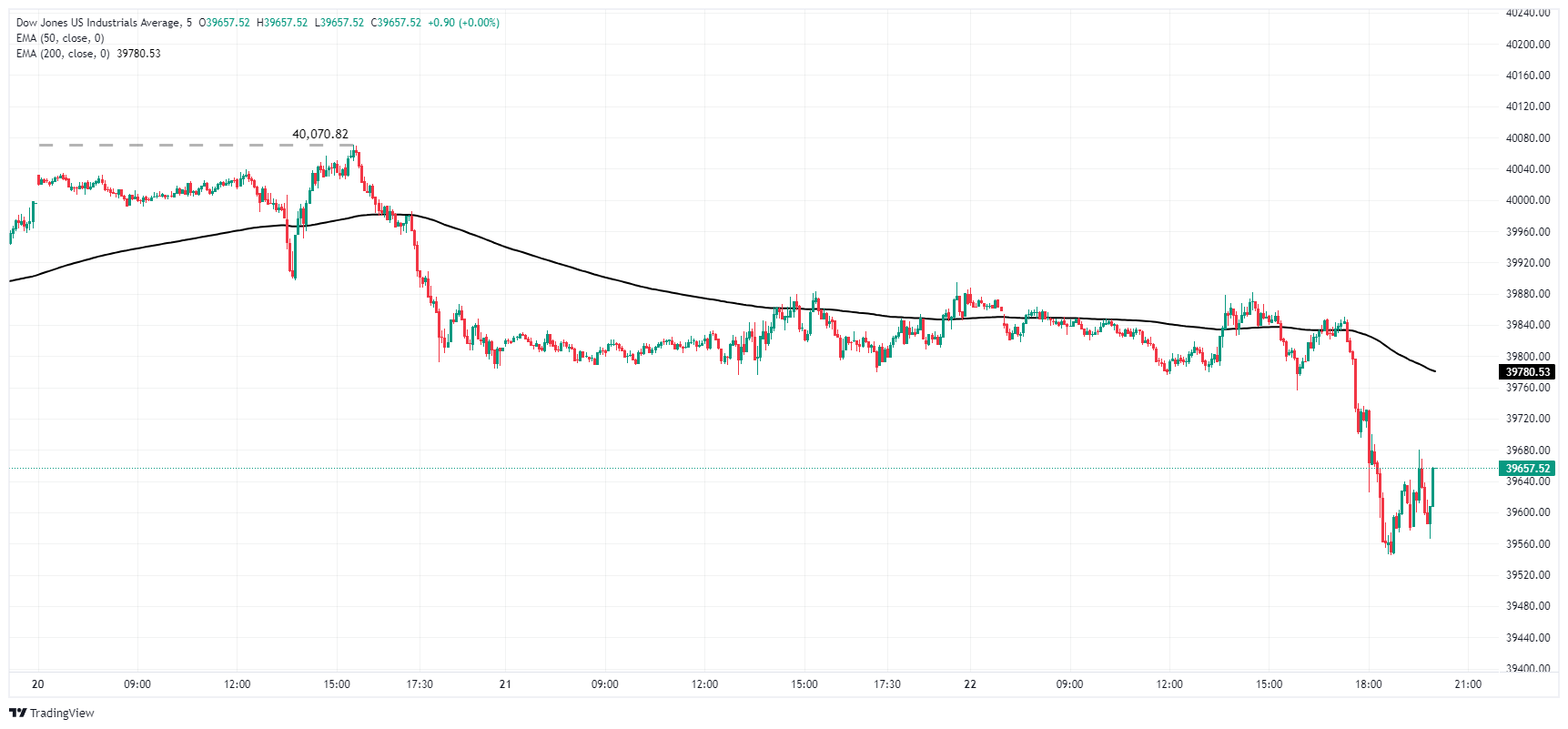Dow Jones falls on Wednesday after Fed Minutes reveal cautious FOMC

- Dow Jones slips lower on Wednesday after FOMC Meeting Minutes.
- Hopes for a September rate cut are beginning to dry up.
- US PMI, Durable Goods Orders in the pipe for later in the week.
The Dow Jones Industrial Average (DJIA) slipped back during US market session on Wednesday as investors continue to get pushed back on broad rate cut expectations. A recent decline in US Consumer Price Index (CPI) inflation helped to bolster traders’ confidence in a September rate trim from the Federal Reserve (Fed). However, still-high inflation numbers well above the Fed’s 2% target range and a cautionary warning from Fitch Ratings that global services inflation is likely to remain higher for longer are battering investors’ rate cut dreams.
Read more: Fed Minutes leave the door open to a probable rate cut in September
Fitch Ratings announced on Wednesday that global services inflation will likely remain higher for longer than originally anticipated, meaning interest rates are unlikely to recede nearly as quickly as investors have hoped through all of 2024. According to the CME’s FedWatch Tool, rate markets are pricing in only 60% odds of a quarter-point rate cut from the Federal Open Market Committee (FOMC) in September, tumbling from 70% in a matter of days. In December, rate traders were pricing in better-than-even odds of six rate cuts in 2024 from the FOMC beginning in March. Fast forward to today, and investors are seeing the door slowly close on two rate cuts for the year beginning in September.
The FOMC’s latest Meeting Minutes published on Wednesday, and while the FOMC didn’t completely rule out September rate cut, odds are looking slimmer as Fed policymakers reiterated the need to wait for stronger evidence that inflation would continue easing to the US central bank’s 2% target.
Dow Jones news
The Dow Jones traded mostly flat on Wednesday in the run-up to FOMC Meetings Minutes. Post-FOMC release, the Dow Jones shed around one half of one percent, backsliding around 200 points as investors balk at a Fed less willing to engage in rate cuts as investors continue to hope for.
Dow Inc. (DOW) fell -2.22% on Wednesday, trading below $57.60 and extending a backslide from a 52-week high set only a week ago. On the high side, Johnson & Johnson (JNJ) climbed 1.49% to $153.50 per share after reporting Q1 net profit of $3.26 billion. JNJ had posted a net loss of $68 million the previous quarter.
Dow Jones technical outlook
The Dow Jones has backslid from a recent all-time record high of 40,070.82, but intraday action has found a technical floor at 39,775.00. The equity index has been unable to recapture 39,900.00, but the DJIA remains firmly bullish in the medium-term.
The Dow Jones is trading well above the 200-day Exponential Moving Average (EMA) at 37,142.67 as investors take a breather from a broad-market bull run, but profit-taking remains thin keeping the DJIA bolstered firmly into bull country.
Dow Jones five minute chart
Dow Jones daily chart
Dow Jones FAQs
The Dow Jones Industrial Average, one of the oldest stock market indices in the world, is compiled of the 30 most traded stocks in the US. The index is price-weighted rather than weighted by capitalization. It is calculated by summing the prices of the constituent stocks and dividing them by a factor, currently 0.152. The index was founded by Charles Dow, who also founded the Wall Street Journal. In later years it has been criticized for not being broadly representative enough because it only tracks 30 conglomerates, unlike broader indices such as the S&P 500.
Many different factors drive the Dow Jones Industrial Average (DJIA). The aggregate performance of the component companies revealed in quarterly company earnings reports is the main one. US and global macroeconomic data also contributes as it impacts on investor sentiment. The level of interest rates, set by the Federal Reserve (Fed), also influences the DJIA as it affects the cost of credit, on which many corporations are heavily reliant. Therefore, inflation can be a major driver as well as other metrics which impact the Fed decisions.
Dow Theory is a method for identifying the primary trend of the stock market developed by Charles Dow. A key step is to compare the direction of the Dow Jones Industrial Average (DJIA) and the Dow Jones Transportation Average (DJTA) and only follow trends where both are moving in the same direction. Volume is a confirmatory criteria. The theory uses elements of peak and trough analysis. Dow’s theory posits three trend phases: accumulation, when smart money starts buying or selling; public participation, when the wider public joins in; and distribution, when the smart money exits.
There are a number of ways to trade the DJIA. One is to use ETFs which allow investors to trade the DJIA as a single security, rather than having to buy shares in all 30 constituent companies. A leading example is the SPDR Dow Jones Industrial Average ETF (DIA). DJIA futures contracts enable traders to speculate on the future value of the index and Options provide the right, but not the obligation, to buy or sell the index at a predetermined price in the future. Mutual funds enable investors to buy a share of a diversified portfolio of DJIA stocks thus providing exposure to the overall index.
